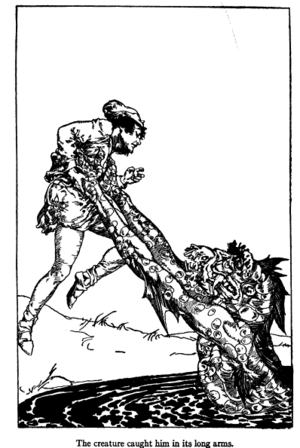Fuath facts for kids

A fuath (pronounced like "vough" or "vaugh") is a type of scary spirit from Scottish Highland folklore. These spirits are often found near water, like rivers, lochs (lakes), or the sea. The word "fuath" actually means 'hate' in Scottish Gaelic.
In a place called Sutherland, there was a mill known as the 'Mill of the Fuath'. People believed this mill was haunted by a fuath and her strange, shapeless son, the brollachan. This mill was next to a stream that flowed into Loch Migdale.
One story tells of a fuath seen at this mill. She had no nose, yellow hair, and wore a green silk dress. In the tale, people managed to capture her using steel, like a sewing needle. But when light was shone on her, she turned into a wobbly, jellyfish-like blob! Another fuath on a nearby farm was said to have webbed feet.
Sometimes, these spirits are believed to have children with humans. Their children are often described as having a mane (like a horse's hair) and a tail.
Contents
What's in a Name?
The word "fuath" is often used as a general term for many different kinds of spirits that live in water. Think of it like a family name for various water creatures.
Another name for these kinds of monsters is arrachd or fuath-arrachd.
Different Kinds of Fuath
Water Spirits and More
While many fuath are known as water spirits, some experts say the term "fuath" can also mean a ghost or goblin in general. This means they don't always have to live in water.
How They Look
Stories about fuath can sometimes mix up details from different tales. For example, the idea that a fuath has a mane and tail actually comes from stories about their human children, not the fuath themselves.
Even though it's often said that fuath wear green, one story tells of a strange woman seen near the River Shin who wore "golden and silken" clothes before she plunged into the water.
Exciting Tales of the Fuath
Many stories about the fuath were collected in the 1800s. These tales often take place around the Skibo estate in Sutherland.
- The Brollachan: This story is about the fuath's son, the brollachan. He was a shapeless blob with eyes and a mouth, but he could only say two words: "Myself" and "Yourself." One day, a man named Murray was at the mill where the brollachan lived. Murray stoked the fire with peat, accidentally burning the brollachan. But because the brollachan could only say "Myself," he couldn't tell anyone who had hurt him!
- The Mill's Kelpie: A brave man from Inveran made a bet that he could capture the "kelpie" (another name for the fuath) from the mill. He succeeded with the help of his black-muzzled dog. He tied the creature to a second horse. As they crossed a stream, the fuath became very upset. The man poked it with an awl and then a sewing needle. The creature cried out that the needle hurt more! When they finally arrived and others shone light on it, the fuath fell down and turned into a shapeless, jelly-like blob, much like the strange "dropped stars" sometimes found on the moors.
- The Nose-less Banshee: At the same mill haunted by the brollachan, people saw a banshee (a type of spirit). She had beautiful yellow hair, like ripe wheat, and wore a fancy green silk dress. But the strangest thing was, she had no nose!
- The Web-footed Kelpie: A shepherd working on a farm found a dirty, limping banshee. He kindly offered to carry her on his back. But as he walked, he noticed something strange: she had webbed feet! Realizing she was a creature of folklore, he quickly threw her off his back and even tossed away the plaid blanket she had been lying on.
Other Spirits Like the Fuath
Some other spirits are thought to be part of the "fuath family" or are very similar to them. These include:
- peallaidh
- fideal
- beithir
- ùruisg
- shellycoat
- nuckelavee
Spirits like the bean nighe or Northern Ireland's uisges are also sometimes compared to the fuath.

